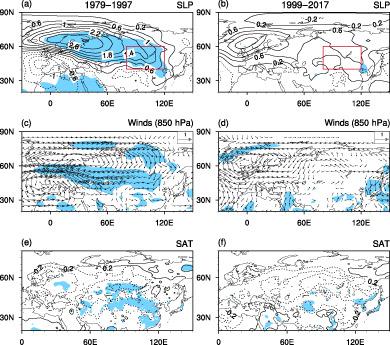当前位置:
X-MOL 学术
›
Int. J. Climatol.
›
论文详情
Our official English website, www.x-mol.net, welcomes your
feedback! (Note: you will need to create a separate account there.)
Weakened impact of autumn Arctic sea ice concentration change on the subsequent winter Siberian High variation around the late‐1990s
International Journal of Climatology ( IF 3.5 ) Pub Date : 2020-10-09 , DOI: 10.1002/joc.6875 Shangfeng Chen 1 , Renguang Wu 1, 2, 3 , Wen Chen 1, 3 , Linye Song 4 , Wei Cheng 3 , Wenjing Shi 3
International Journal of Climatology ( IF 3.5 ) Pub Date : 2020-10-09 , DOI: 10.1002/joc.6875 Shangfeng Chen 1 , Renguang Wu 1, 2, 3 , Wen Chen 1, 3 , Linye Song 4 , Wei Cheng 3 , Wenjing Shi 3
Affiliation

|
Previous studies suggested that autumn Arctic sea ice concentration (SIC) change around the Kara–Laptev seas has a marked impact on the following winter Siberian High (SH). This analysis reveals that the autumn Arctic SIC‐winter SH connection experienced a marked interdecadal weakening around the late‐1990s according to observational and reanalysis data. Before the late‐1990s, autumn Arctic SIC loss induces pronounced Arctic warming via modulating surface heat fluxes and reduces poleward meridional temperature gradient, which leads to weakening of westerly winds over mid‐latitude Eurasia and contributes to formation of a high‐pressure ridge around Ural mountain. The Ural high‐pressure ridge provides a favourable dynamical condition for the amplification of SH. Consequently, the autumn Arctic SIC‐winter SH connection is strong. In addition, the North Atlantic is dominated by a marked triple sea surface temperature anomaly pattern from autumn to winter, which also partly contributes to a strengthened SH via modulating the Ural high‐pressure ridge. After the late‐1990s, Arctic warming and atmospheric anomalies over Eurasia related to the autumn Arctic SIC loss are much weaker. Accordingly, the autumn Arctic SIC‐winter SH connection is very weak. Changes in the autumn Arctic SIC‐related Arctic warming and atmospheric anomalies are suggested to be related to differences in the autumn Arctic SIC anomalies, with a much weaker amplitude and northward retreat after than before the late‐1990s. Further analysis indicates that the weaker autumn Arctic SIC anomalies over Kara–Laptev seas after the late‐1990s is related to the northward retreat of the mean Arctic SIC.
中文翻译:

秋季北极海冰浓度变化对随后的1990年代后期冬季西伯利亚高压变化的影响减弱
先前的研究表明,卡拉–拉普捷夫海周围的秋季北极海冰浓度(SIC)变化对随后的冬季西伯利亚高压(SH)具有显着影响。该分析表明,根据观测和再分析数据,秋季北极SIC冬季SH连接在1990年代后期经历了年代际减弱。在1990年代后期之前,秋季北极SIC损失通过调节表面热通量引起明显的北极变暖,并降低了极地子午线温度梯度,从而导致中纬度欧亚大陆上的西风减弱,并导致乌拉尔附近形成高压脊。山。乌拉尔高压山脊为SH的扩增提供了有利的动力学条件。因此,秋季的北极SIC-冬季SH连接牢固。此外,从秋季到冬季,北大西洋以明显的三重海表温度异常模式为主,这也部分通过调制乌拉尔高压海脊而增强了南海。1990年代后期以来,与秋季北极SIC损失有关的北极变暖和欧亚大陆的大气异常要弱得多。因此,秋季的北极SIC冬季SH连接非常弱。秋季北极SIC相关的北极变暖和大气异常的变化被认为与秋季北极SIC异常的差异有关,与1990年代后期之前相比,其振幅和北退程度要弱得多。进一步的分析表明,1990年代后期以来卡拉–拉普捷夫海域较弱的秋季北极SIC异常与平均北极SIC的北退有关。
更新日期:2020-10-09
中文翻译:

秋季北极海冰浓度变化对随后的1990年代后期冬季西伯利亚高压变化的影响减弱
先前的研究表明,卡拉–拉普捷夫海周围的秋季北极海冰浓度(SIC)变化对随后的冬季西伯利亚高压(SH)具有显着影响。该分析表明,根据观测和再分析数据,秋季北极SIC冬季SH连接在1990年代后期经历了年代际减弱。在1990年代后期之前,秋季北极SIC损失通过调节表面热通量引起明显的北极变暖,并降低了极地子午线温度梯度,从而导致中纬度欧亚大陆上的西风减弱,并导致乌拉尔附近形成高压脊。山。乌拉尔高压山脊为SH的扩增提供了有利的动力学条件。因此,秋季的北极SIC-冬季SH连接牢固。此外,从秋季到冬季,北大西洋以明显的三重海表温度异常模式为主,这也部分通过调制乌拉尔高压海脊而增强了南海。1990年代后期以来,与秋季北极SIC损失有关的北极变暖和欧亚大陆的大气异常要弱得多。因此,秋季的北极SIC冬季SH连接非常弱。秋季北极SIC相关的北极变暖和大气异常的变化被认为与秋季北极SIC异常的差异有关,与1990年代后期之前相比,其振幅和北退程度要弱得多。进一步的分析表明,1990年代后期以来卡拉–拉普捷夫海域较弱的秋季北极SIC异常与平均北极SIC的北退有关。











































 京公网安备 11010802027423号
京公网安备 11010802027423号